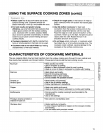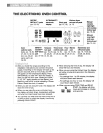
USING THE SURFACE COOKING ZONES (contd.)
i iiiiiiii iiliili!!i_i!!!iiii:iiii_i!iii:iiiii!!iiiililiii! ¸ i!i
Cooking on the radiant lass cooktop is similar
to cooking on coil
elements. There are,
however, a few
differences:
• The surface cooking
zone will glow red when
the element is turned on.
You will see the element
cycling on and off - even
on the HI setting - to
prevent the glass from overheating.
• Do not cook foods directly on the cooktop.
• Sugary or starch spills, believers, and some soils
can cause pitting. Wipe as soon as the hot
surface indicator light goes off. Rinse thoroughly
and dry. See "Cleaning the radiant glass
cooktop" in the "Caring for Your Range" section,
p. 42, for more information.
• Do not cook popcorn that comes in prepackaged
aluminum containers on the cooktop. The
container could leave aluminum marks on the
cooktop that cannot be removed completely.
• Make sure the bottoms of pots and pans are
clean and dry before using them. Food and water
particles left on the bottoms can leave deposits
on the cooktep when it is heated.
• Lift pots and pans onto and off of the cooktop.
Sliding pots and pans on the cooktop could leave
marks that are difficult to remove or could leave
permanent marks.
• Dropping a heavy or hard object on the cooktop
could crack it. Be careful when using heavy
skillets and large pots. Do not store jars or cans
above the cooktop.
• Do not use the cooktop as a cutting board.
• Do not allow anything that could melt, such as
plastic salt and pepper shakers, to come in
contact with the cooktop while it is hot.
• Wiping off the ceoktop before and after each use
will help keep the surface free from stains and
give you the most even heating. See "Cleaning
the radiant glass cooktop" in the "Caring for Your
Range" section, p. 42, for care and cleaning
suggestions.
: ,r
TO protect your range=
• Use flat-bottomed canners on all types of
cooktops, especially
centerover
= i surfacecooking _, i
u I area I i
I -- I
=1" 1 inch 1" =
i maximum i
,1 o va; ugJ-'
Surface Pan
, cooking zone
radiant glass. Canners
with rippled or ridged
bottoms do not allow
good contact with the
surface.
• Center the canner
over the largest surface
cooking zone. Do not
extend more than one
inch outside the surface
cooking zone. Large diameter canners/pans, if not
centered correctly, trap heat and can cause
damage to the cooktop.
• Do not place your canner on two surface cooking
zones at the same time.
When canning for long periods of time, allow
surface cooking zones and the surrounding
surfaces to cool down.
Alternate use of the surface cooking zones
between batches or prepare small batches at a
time.
• Start with hot water, cover with a lid, and bring
to a boil; then reduce heat to maintain a boil or
required pressure levels in a pressure canner.
• For up-to-date information on canning, contact
your local U.S. Government Agricultural
Department Extension Office or companies
who manufacture home canning products.
• The type of material the canner is made of
determines the length of heating time. Refer to
the "Characteristics of cookware materials" chart,
p. 11.
10


















